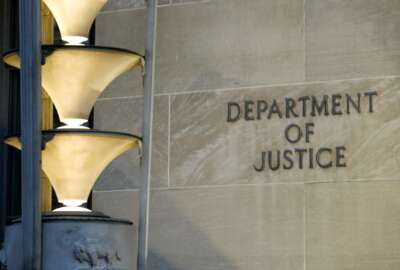Federal attorneys group urges DOJ to fix pay disparity, set new policy for telework
National Association of Assistant U.S. Attorneys tells DoJ that its pay systems are leading to a disparity in what attorneys earn.
The Justice Department isn’t going through the “great resignation” that’s shaking up businesses across the country.
But assistant U.S. attorneys (AUSAs) are telling the agency to address pay disparities and set a department-wide standard for telework to prevent them from leaving government for careers in the private sector.
National Association of Assistant U.S. Attorneys (NAAUSA), which represents more than 6,300 criminal prosecutors and civil attorneys, is telling the DOJ that its pay systems are leading to a disparity in what attorneys earn, which hurts recruitment and retention.
The association, meanwhile, is calling for the Justice Department to set a department-wide policy that would allow AUSAs to telework at least two days a week, rather than leave those workplace flexibilities up to individual U.S. attorneys’ offices.
NAAUSA Vice President Adam Hanna said the Administratively Determined pay plan that assistant U.S. attorneys fall under puts them at a disadvantage compared to the General Schedule pay scale used for most other DOJ attorneys.

While DOJ, much like the rest of the federal government, can’t compete with top private-sector law firms on pay, Hanna said the agency should at least address the pay gap within the agency, in order to attract and retain in-demand legal talent.
“Large law firms love to hire folks who’ve been assisting United States attorneys,” Hanna said. “They come in, they’ve been well trained by the federal government, they’ve gotten the best of training, the best of resources. It simply doesn’t take that much money to lure some AUSAs away because of this massive disparity in pay,” Hanna said.
Hanna said AUSAs experience the greatest pay disparity in the first 10-to-15 years of their careers. Data from NAAUSA shows that the annual pay disparity between a GS-15 with five years of experience and an assistant U.S. attorney with the same amount of experience is greater than $46,000.
In anonymous testimonials collected by NAAUSA, AUSAs repeatedly told the association that they had taken pay cuts to continue serving as criminal prosecutors or civil attorneys.
“Once you’ve been around for 20 or 25 years , maybe the difference isn’t that great. But that means our attorneys are going under-compensated for decades of their working lives and really impacting every aspect of their earnings and their retirement in that way,” Hanna said.
Pay satisfaction scores for employees in the U.S. Attorney’s Office have been among the lowest 25% of agency scores in the Partnership for Public Service’s Best Places to Work in the Federal Government Survey for more than a decade.
In 2020, the Executive Office of U.S. Attorneys and U.S. Attorneys’ Office ranked 359 out of 407 in terms of agency subcomponents’ attitudes about pay.
Hanna said NAAUSA has brought the issue up with DOJ leadership over the past 20-to-30 years, and estimates that it would cost the agency about $40-to-$50 million to equalize the pay of AUSAs with what their colleagues earn through the General Schedule system.
“We’ve had a lot of good dialogue with leaders, both in this administration and in the last one. I think it’s just a matter of really coming up with a plan to fix this inequity once and for all,” he said.
A DOJ spokesman said the “department continually examines and adjusts compensation to ensure that it hires and retains the most diverse and qualified workforce possible.”
NAAUSA is also pressing the agency to set aside more money to support pay raises and promotions for AUSAs this year.
The association, in a letter to Robert Wilkinson, the director for the Executive Office for U.S. Attorneys, is calling for a minimum of 4.8% of non-capped onboard AUSA salaries for the 2022 Annual Pay Review process.
Hanna said that every January, AUSAs go through a performance appraisal with their supervisors, to determine whether they’re helping DOJ meet its strategic goals, and whether they’re is performing well on all the elements of their performance work plans.
Attorneys that receive an “outstanding” on that review may be eligible for promotion, which may have a new minimum salary requirement.
As part of this process, DOJ’s Executive Office for United States Attorneys issues a memo each spring notifying U.S. attorney’s offices about the funding available for APRs that year.
“That’s what the U.S. attorney in each district has to work with in terms of funding those pay increases for AUSAs,” Hanna said. “Those raises can vary greatly from person to person. Some folks would be entitled to non-discretionary raises because of a promotion. Other folks might not be entitled to any non-discretionary increase, it may just be totally at the discretion of the U.S. attorney whether or not to give them a raise.”
Last year, DOJ created a pool equal to 2.5% of non-capped AUSA salaries for raises—an amount that NAAUS says “is simply insufficient,” given the current rate of inflation.
NAAUSA presses for 2 days of telework per week
The association, meanwhile, is calling on DOJ to allow AUSAs to telework at least two days a week, as long as it doesn’t conflict with their job duties.
In a letter to Deputy Attorney General Lisa Monaco, NAAUSA President Steve Wasserman said DOJ is “at a critical juncture for workplace policy,” and should keep up the legal community’s embrace of telework that began at the start of the COVID-19 pandemic.
NAAUSA said DOJ is currently taking a decentralized approach to telework that leaves workplace flexibility up to the discretion of U.S. attorneys.
“While some U.S. Attorney Offices allow significant telework flexibility, some offer none or nearly none. NAAUSA members have raised health and wellbeing concerns at USAOs that revoked telework flexibility as soon as possible without ensuring adequate safety measures were in place to protect employee health,” Wasserman wrote.
In a survey of more than 700 AUSAs, 95% of respondents said they were successfully able to do their job teleworking, and 93% supported a department-wide policy of two days of telework a week.
“If you look at the last nearly two years, I would say that AUSAs have maintained an extremely high level of productivity and efficiency in their work,” Hanna said. “We’ve managed to keep the federal criminal justice system working through a pandemic emergency, we’ve managed to continue to keep the public safe from criminals. We’ve continued in civil litigation where the government’s involved.”
Hanna said AUSAs are still generally on maximum telework to keep office occupancy at a minimum during an omicron surge of COVID-19, but attorneys are permitted to go into the office for meetings, get work done or check their mail.
“Attorneys and support staff know that they need to come in if something requires it, but our productivity has increased while teleworking. In fact, we have routinely demonstrated we can do so successfully and without compromising our duties to the public,” one AUSA from the Eastern District of Texas said as part of the association’s telework survey.
One AUSA in the Central District of California acknowledged some IT challenges related to working remotely, but said “the answer is more funding for IT infrastructure — not making AUSAs return.”
An assistant U.S. attorney with the Eastern District of Pennsylvania said they worked in the private sector for more than a decade before working for the DOJ and said working remotely never became an issue.
“In private practice, no one cared where you were as long as the work got done. I never understood why USAO treats work like shifts at GM, punching a clock and sitting at a desk.” the attorney said.
Copyright © 2025 Federal News Network. All rights reserved. This website is not intended for users located within the European Economic Area.
Jory Heckman is a reporter at Federal News Network covering U.S. Postal Service, IRS, big data and technology issues.
Follow @jheckmanWFED






